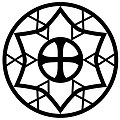| American Church in Paris | |
|---|---|
Église américaine de Paris | |
 Street view of the American Church in Paris from the Quai d'Orsay | |
| 48°51′44.0″N2°18′23.7″E / 48.862222°N 2.306583°E | |
| Location | Paris |
| Country | France |
| Denomination | Interdenominational |
| Website | acparis.org |
| History | |
| Former name(s) | American Chapel in Paris |
| Founded | 1814 |
| Dedication | 1931 |
| Architecture | |
| Style | 15th century Gothic |
| Groundbreaking | March 1, 1926 |
| Completed | September 6, 1931 |
| Specifications | |
| Capacity | 600 (main level), 100 (balcony) |
| Clergy | |
| Senior pastor(s) | Rev. Dr. Paul Rock |
 | |
The American Church in Paris (formerly the American Chapel in Paris) was the first American church established outside the United States. It traces its roots back to 1814, and the present church building - located at 65 Quai d'Orsay in the 7th arrondissement of Paris, France - dates to 1931.









